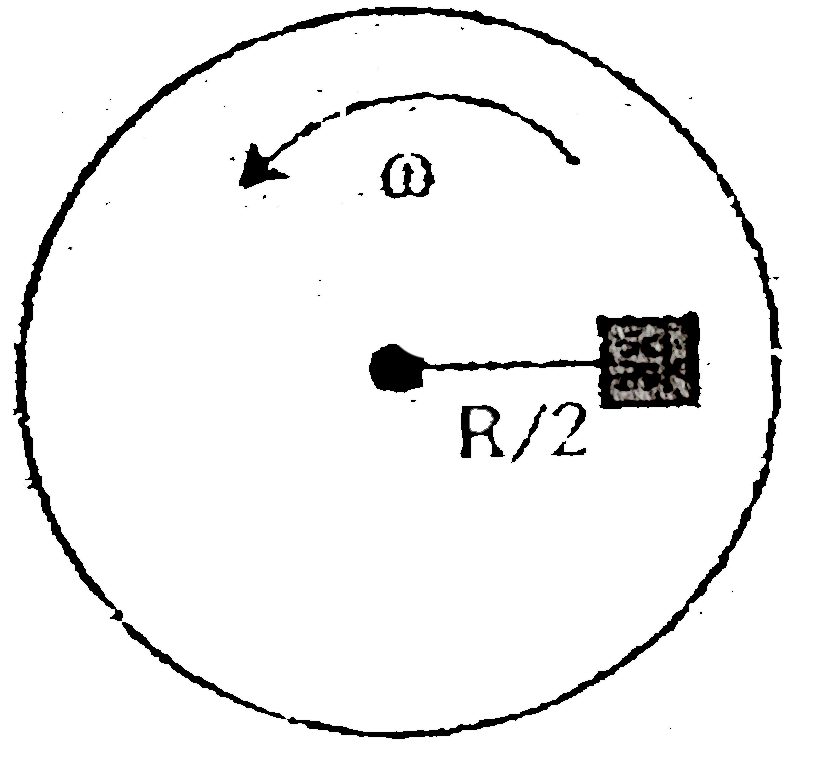A disc of radius R=2m starts rotating wth constant angular acceleration α=(2rad/s2). A block of mass m=2kg is kept at a distance R2 from the centre of disc. The coeffiecient of friction between disc and block is μs=0.4,μk=0.3. Acceleration of block when it just slips w.r.t. ground and w.r.t. disc are respectively−(g=10ms−2)Solution in Gujrati
3ms−2,1ms−2
1ms−2,3ms−2
4ms−2,1ms−2
4ms−2,3ms−2
The correct Answer is:A
Acceleration of block w.r.t. ground when it just slips =μkg=(0.3)(10)=3ms−2

Acceleration of block w.r.t. disc when it just
slips=mω2r−μkmgm
μsmg−μkmgm
=(μs−μk)g=(0.4−0.3)(10)=1ms−2
Topper's Solved these Questions
- TEST PAPERBOOK - ALLEN CHAPTER - TEST PAPEREXERCISE - PHYSICS
4 Videos
- TEST PAPERBOOK - ALLEN CHAPTER - TEST PAPEREXERCISE - PHYSICS
4 Videos
- SIMPLE HARMONIC MOTIONBOOK - ALLEN CHAPTER - SIMPLE HARMONIC MOTIONEXERCISE - Example
1 Videos
- TEST PAPER 1BOOK - ALLEN CHAPTER - TEST PAPER 1EXERCISE - PHYSICS
11 Videos
Similar Questions
Choose the correct statement:
View SolutionChoose the correct statement:
View SolutionA rod with rectangular cross section oscillates about a horizontal axis passing through one of its ends and it behaves like a seconds pendulum, its length will be
View SolutionWhy are electric field lines perpendicular at a point on an equipotential surface of a conductor ?
View SolutionA disc of radius R rotates from rest about a vertical axis with a constant angular acceleration such that a coin placed with a tangenitial between a as shown in figure If the coefficient of static friction between the coin and disc is mu_(s) .Find the velocity of the before it start sliding relative as the disc
View SolutionIn figure calculate the linear acceleration of the blocks. Mass of block B= 8kg mass of disc shaped pulley =2kg (take g=10m//s^(2) )
View SolutionA small coin of mass 80g is placed on the horizontal surface of a rotating disc. The disc starts from rest and is given a constant angular acceleration alpha=2rad//s^(2) . The coefficient of static friction between the coin and the disc is mu_(s)=3//4 and cofficient of kinetic friction is mu_(k)=0.5 . The coin is placed at a distance r=1m from the centre of the disc. The magnitude of the resultant force on the coin exerted by the disc just before it starts slipping on the disc is
View SolutionA circular disc with a groove along its diameter is placed horizontally . A block of mass 1 kg is placed as shown . The coefficient of friction between the block and all surfaces of groove in contact is μ=2/5 . The disc has an acceleration of 25m/s2 . find the acceleration of the block with respect to disc .

View SolutionA disc of radius is rotatating with angular frequency 10 rad/sec. A block of mass 2 kg is to be put on the disc frication coefficient between disc and block is mu_(K)= 0.4 , then find the maximum distance from axis where the block can be placed without slidding:
View SolutionA coins kept on a horizontal rotating disc has its centre at a distance of 0.25 m from the axis of rotation of the disc .If μis0.2, then the angular velocity of the disc at which the coion will slip off, (g=9.8m/s2)
View SolutionA body is kept on a horizontal disc of radius 2 m at a distance of 1 m from the centre . The coefficient of friction between the body and the surface of disc is 0.4. The speed of rotation of the disc at which the body starts slipping is (g=10m/s2)
View SolutionA small coin of mass 40 g is placed on the horizontal surface of a rotating disc. The disc starts from rest and is given a constant angular acceleration alpha="2 rad s"^(-2) . The coefficient of static friction between the coin and the disc is mu_(s)=3//4 and the coefficient of kinetic friction is mu_(k)=0.5. The coin is placed at a distance r=1m from the centre of the disc. The magnitude of hte resultant force on the coin exerted by the disc just before it starts slipping on the disc is :
View SolutionA disc of radius 4m is rotating about its fixed centre with a constant angular velocity 2rads (in the horizontal plane).A block is also rotating with the disc without slipping. If co-efficient of friction between the block and the disc is 0.4 ,then the maximum distance at which the block can rotate without
View SolutionThe inertia of a disc is deceptive 100 g.cm ^ 2. The disc rotates at an angular speed of 2rad / s. The rotational motion of the disc is
View SolutionA body is kept on a horizontal disc of radius 2 m at a distance of 1 m from the centre . The coefficient of friction between the body and the surface of disc is 0.4. The speed of rotation of the disc at which the body starts slipping is (g=10m/s2)
View SolutionA disc of radius R rotates from rest about a vertical axis with a constant angular acceleration such that a coin placed with a tangenitial between a as shown in figure If the coefficient of static friction between the coin and disc is mu_(s) .Find the velocity of the before it start sliding relative as the disc
View Solution
